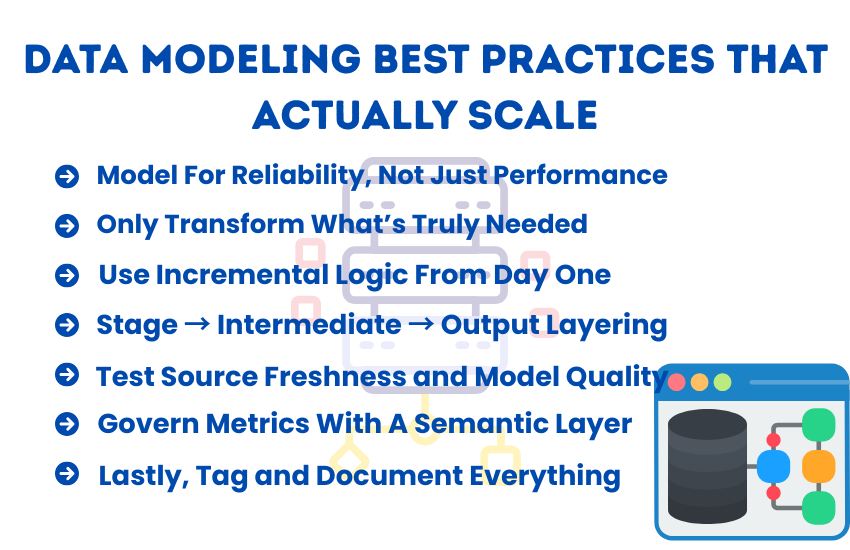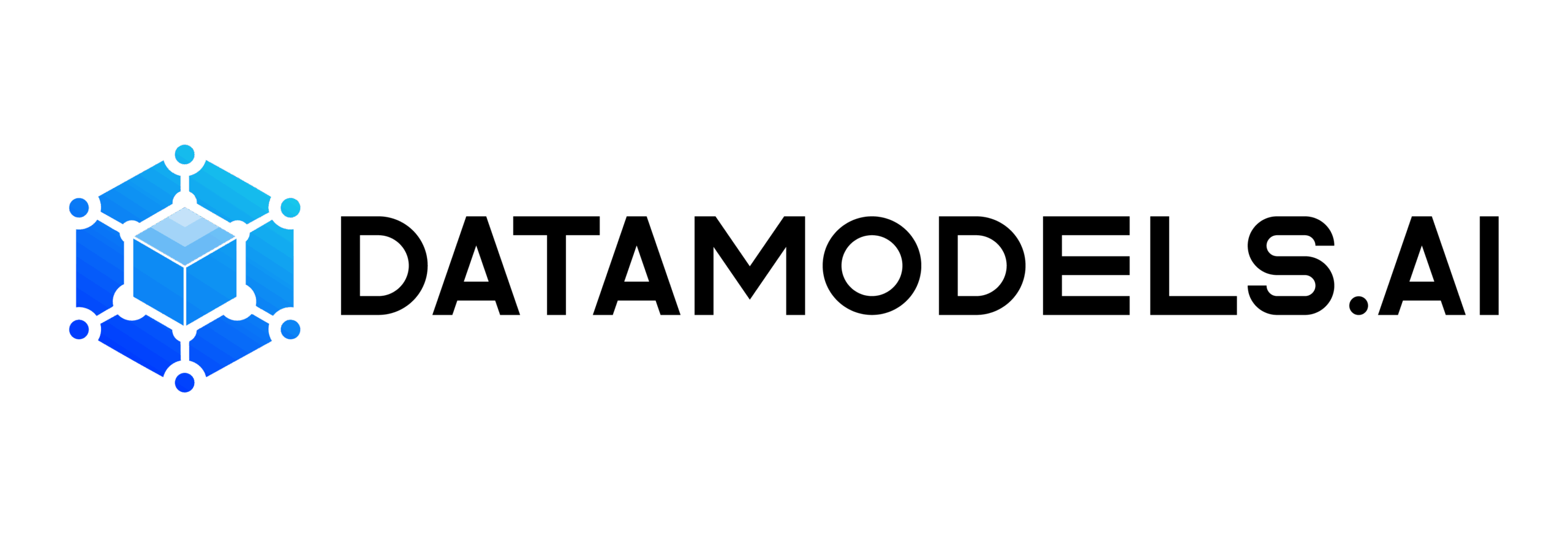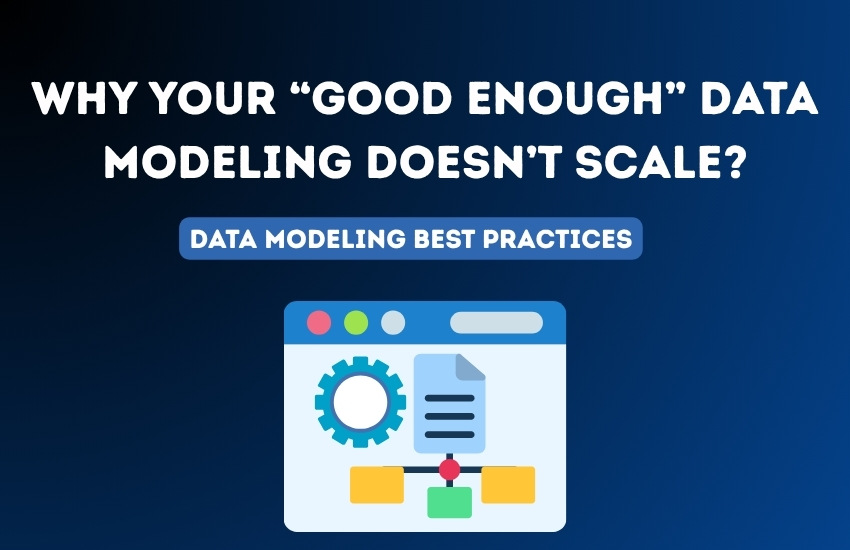Your dashboards are slow. Stakeholders don’t trust the numbers. Your team’s buried in 300-line SQL files. Sound familiar? Then your “good enough” modeling isn’t good enough.
You might think your data modeling was fine — it shipped dashboards, unblocked teams, and didn’t break… yet. But the is, “good enough” doesn’t scale.
As your org grows, so does complexity — more data, more stakeholders, and more pressure to deliver fast, trusted insights. What once worked for a few data analysts now leads to duplicated metrics, slow queries, and mounting tech debt.
If your modeling isn’t built for speed, reliability, and reuse, it’s quietly dragging your team down.
In this guide, we’ll break down the data modeling best practices that actually scale — so you can move faster, trust your metrics, and stop firefighting broken dashboards.
The Role of Data Modeling In A Modern Analytics Stack
Data modeling isn’t just a technical layer in your warehouse. It’s the blueprint for how your business sees the world.
You’re not just structuring tables — you’re defining how decisions get made, how revenue is reported, and how fast your teams can move. When done right, great modeling reduces friction, eliminates guesswork, and enables confident decisions at every level of the org.
The data modeling practices that scale are now the backbone of modern analytics stacks. From SaaS startups to enterprise fintechs, the pressure to move fast without losing trust has forced teams to rethink their foundations.
Here’s what scalable modeling actually delivers:
- Reusable and governed metrics that eliminate “why don’t these numbers match?”
- Cost-efficient queries by avoiding bloated joins or unnecessary materialization
- Faster onboarding of new analysts and engineers — thanks to clarity and standardization
- Consistent, explainable logic across BI tools, departments, and reports
- Future-proofing your stack — so you’re not rebuilding models every quarter
When teams treat data modeling as an afterthought, they end up duct-taping fixes, maintaining spaghetti SQL, and burning hours debugging metrics instead of delivering results.
That’s not a stack — it’s a liability.
So, what should scalable, modern modeling look like?
Let’s walk through the 7 most effective data modeling strategies we’ve seen across dozens of real-world teams and how you can apply them now.
Read Also: Data Quality Checklist To Fix Dirty Data
7 Data Modeling Best Practices That Actually Scale

Not all modeling advice holds up under pressure. What works in a scrappy prototype often falls apart when you introduce new sources, users, and expectations.
If you’ve ever had to reverse-engineer someone else’s logic buried in a 300-line SQL file, you already know how painful this gets.
Let’s cut through the noise.
1. Model For Readability, Not Just Performance
Sure, shaving two seconds off query time feels good, but if no one understands what your model does or how it works, you’re just building technical debt faster.
Readable models make teams faster, not just queries. So,
- Follow dbt standards like stg_, int_, dim_, fct_. This signals where logic lives and makes handoffs easier.
- Document what the model does, where it’s used, and who owns it. It takes minutes but saves hours later.
- Skip complex SQL hacks if they make the model unreadable. Simple logic scales better than smart-but-cryptic joins.
If a model breaks and only one person can fix it, it’s a liability. Your models should be understandable by anyone on the team — even someone new.
Clear is scalable. Clever is not.
2. Don’t Over-Model – Transform Only What’s Needed
When every stakeholder asks for a slightly different version of the same metric, it’s tempting to create another model. And another. And another.
Soon, you’re buried under model bloat — dozens of variations doing 90% of the same thing.
Instead, focus on:
- Modular models that solve common needs and can be reused.
- Thin transformation layers unless the logic is complex or broadly reused.
- Push rare cases downstream into BI tools or handle them with filters.
Ask yourself:
“Does this need to be its own model, or is there a smarter way to reuse what we’ve already built?”
Over-modeling might feel productive, but it’s one of the fastest ways to break trust and create unmanageable complexity.
3. Apply Incremental Logic From Day One
Think your dataset’s too small for incremental loads? That’s exactly when to start.
When you wait until things get “big,” the rework is painful, urgent, and error-prone. But if you design with incremental logic upfront, you set the stage for:
- Massively faster runs as data volume grows
- Lower cloud compute costs when you’re not reprocessing stale data
- Greater control over backfills, late-arriving data, and partitioning logic
With dbt, this means using is_incremental() blocks, partition keys, and automated freshness tests early on, even when it feels like overkill.
What feels like overhead today becomes your advantage tomorrow.
4. Build A Clear Staging → Intermediate → Output Layer
A tangled pipeline is a silent killer. When logic is scattered or repeated across models, every bug takes longer to trace, and every change risks downstream breakage.
That’s why a layered modeling architecture is a game-changer.
Here’s how we structure it:
- Staging (stg_): Ingest raw tables, standardize column names, fix types — no business logic here.
- Intermediate (int_): Join tables, apply transformations, and define reusable logic used across domains.
- Output (dim_, fct_): These are your final models feeding dashboards, reports, or API endpoints.
Why does this matter?
- Debugging gets faster – you isolate the problem by layer.
- Ownership becomes clear – each layer can be assigned and maintained confidently.
- Governance improves – you track and document where business logic lives.
If your current models are flat and overloaded, breaking them into layers is the first step toward scalable data modeling.
Read Also: Fix These 10 Data Pipeline Issues
5. Use Source Freshness and Model Tests Aggressively
You can’t trust what you don’t test.
Silent failures are one of the biggest causes of broken dashboards, missed revenue signals, and executive frustration. Worse, your pipeline may look “green” even when the data inside is stale or incomplete.
To prevent that, high-performing teams implement:
- Freshness tests
Validate that source tables are updated on time (e.g., using dbt_source_freshness).
- Schema and data tests
Use not null, unique, and referential integrity checks to catch upstream issues.
- Custom validations
Add row count or range logic to catch outliers early.
Remember: don’t just add tests — monitor them. Dashboards and alerts make the difference between “we caught it first” and “the CMO flagged it again.”
Data modeling for BI and AI isn’t just about shape, it’s about trust.
6. Prioritize Semantic Layer Governance Early
If five analysts write five versions of the same metric, do any of them mean the same thing?
SQL sprawl kills confidence. When business logic lives in dashboards, Excel, or ad hoc queries, even a perfect model won’t save you.
That’s where the semantic layer comes in.
Tools like dbt Metric Layer, Cube.dev, or LookML let you centralize key metrics so everyone’s pulling the same numbers from the same definitions every time.
- Define metrics once and reuse them everywhere
- Enforce consistency across Looker, Tableau, Power BI
- Remove logic from dashboards and put it in version-controlled layers
It’s also a must for data modeling in BI and AI, where consistent, governed data feeds ML models or powers self-service reporting.
Don’t delay this until it’s a problem—make governed data models your foundation.
7. Tag and Document Everything – Not Just For You
It’s tempting to think, “I’ll remember what this model does.” You won’t.
Neither will your teammates. Or the person who inherits your pipeline next quarter.
That’s why we push teams to tag and document aggressively. Not just the major models but all of them.
Use metadata like:
- Purpose: What is this model used for?
- Owner: Who is responsible for it?
- Status: Is it active, deprecated, or archived?
Tags: Domain (finance, marketing), pipeline (snowflake, fivetran), priority, and more.
This helps:
- Accelerate onboarding for new hires
- Identify dead or unused assets quickly
- Perform audits when migrations or platform shifts happen
The most reusable data models aren’t just technically clean; they’re easy to understand, track, and improve.
Read Also: Migrate From Teradata To Snowflake
Common Anti-Patterns That Kill Scalability
Even teams with solid foundations can fall into habits that slowly erode trust, velocity, and model performance. These anti-patterns are sneaky. They usually start with “just this once,” and before long, they become your team’s default.
If your dashboards are breaking too often, your queries are sluggish, or your logic feels unexplainable even to you… chances are, one or more of these patterns are at play.
Let’s break them down so you can spot (and fix) them early.
Overloading Final Models With Business Logic
You want a dashboard-ready table, so you jam all the logic into the final model. Seems efficient, right?
Until someone changes a filter or joins in another dashboard and breaks everything.
When final models are packed with complex joins, nested CTEs, and domain logic, they become:
- Hard to debug: Where did this number come from? Why is it different now?
- Impossible to reuse: Every change requires cloning or copying.
- Brittle: A small upstream change causes cascading failures.
Instead, push business logic to intermediate layers or the semantic layer. Final models should be clean, simple, and focused on consumption.
Think of output models like an API. Consistent, documented, and tightly scoped.
Repeating Transformations In Every Dashboard
If each dashboard or report has its own custom logic, you’ve already lost control.
This is the root of inconsistent metrics, broken trust with stakeholders, and weekly Slack threads asking, “Why don’t these numbers match?”
Common culprits:
- Joins done in Looker explores or Tableau data sources
- KPIs calculated slightly differently in every report
- Filters applied inconsistently across teams
Instead, centralize metric logic in your dbt models or semantic layer. This ensures:
- Shared logic is used everywhere
- Changes propagate predictably
- Time-to-insight shrinks (no rework)
“Defined once, trusted everywhere” should be your BI mantra.
No Ownership Or Lineage Tracking
Who owns this model? What happens if we deprecate it? Which dashboards will break?
Without clear lineage and ownership, data teams move slower, and mistakes get more expensive.
Symptoms include:
- Models with no documentation or assigned owner
- Inability to trace a metric back to source logic
- Stakeholders learning something broke, only after reporting it
Fix this by adopting metadata tools (like dbt docs, Atlan, or OpenMetadata) and embedding ownership in your workflow.
- Add owner: and description: fields to every model
- Use tags to group by team or priority
- Map dashboards to upstream sources so nothing breaks silently
Scalable data modeling means treating metadata as part of your product, not an afterthought.
The Modeling Habits of High-Performing Analytics Teams

There’s a visible difference between teams constantly putting out fires and teams whose models just work. It’s not about having more engineers or newer tools. It’s about smarter habits built into the way they model, test, and collaborate.
If you want faster insights, fewer breaks, and scalable trust, these are the modeling behaviors we see in top-performing teams across industries.
Cost-Aware Modeling
Even with generous warehouse credits, costs creep up—especially when models aren’t built with scale in mind. High-performing teams don’t just model for speed or completeness; they model for cost-efficiency.
They regularly:
- Avoid unnecessary joins that bloat compute, especially wide fact tables or many-to-many relationships
- Use views or ephemeral models for lightweight logic that doesn’t require full materialization
- Materialize smartly, reserving incremental or table builds only for models with proven performance gains
- Review cost metrics like they would engineering infra — flagged, explained, and optimized routinely
Ask yourself: Does this model need to run daily? Can we cache part of it?
The best model isn’t necessarily the fanciest, but rather the one that delivers value without draining your budget.
Biweekly Model Review Rituals
You hold sprint reviews for products. Why not for data models?
Top teams treat data models like evolving assets — not one-off scripts. They schedule regular model reviews, typically every two weeks, to:
- Audit new models and changes
- Flag confusing or risky logic
- Deprecate unused or duplicated models
- Document changes for downstream users
This habit:
- Prevents sprawl before it happens
- Improves cross-team alignment
- Encourages better documentation and governance
| Bonus! These reviews often reveal shadow logic sitting in dashboards that should move upstream — a big win for reusable data models. |
Shared Ownership Across Teams
Modeling isn’t just a “data team” job.
The most resilient analytics environments involve stakeholders from GTM, finance, product, and operations before issues arise.
How they do it:
- Involve domain experts in metric definitions
- Co-own logic with finance or marketing when KPIs are on the line
- Make model and dashboard reviews a cross-functional habit
- Use shared Slack channels or tools like Notion to document definitions
This kind of collaboration avoids “he said, she said” debates when numbers don’t align because everyone knows where the logic lives and how it’s defined.
Data modeling for BI and AI is a team sport. The sooner you treat it that way, the fewer trust gaps you’ll face.
Final Thoughts
“Good enough” doesn’t scale. Not in the product, not in infra, and definitely not in your data models.
Quick fixes might work early on. But as your business grows, so do the risks: inconsistent metrics, broken dashboards, and frustrated stakeholders who stop trusting the data.
Scaling isn’t about doing more but doing what matters, i.e., aligning models to business logic, enforcing tests, and building clean layers that teams can trust.
Whether you’re a team of five or fifty, now’s the time to fix it before you’re forced to rebuild under pressure.
Want Cleaner Models and Faster Dashboards?
We help analytics teams model smarter. So you get:
- Faster insights
- Lower warehouse costs
- Fewer “why doesn’t this metric match?” moments
Want a free model audit or architecture review? Book your free consultation now, and let’s make your data stack scalable and stress-free.

